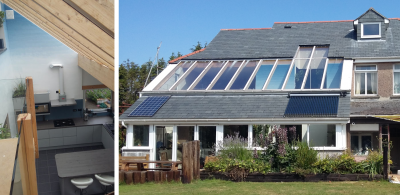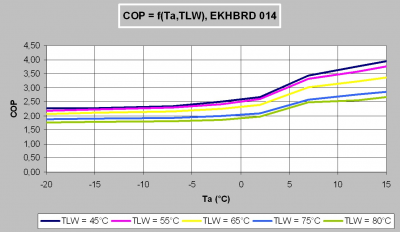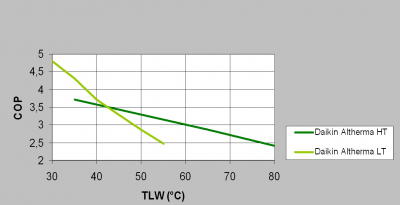I'm grateful for your input, but it doesn't really help me. I'm not looking to rip out the floor. I'm investigating the possibility of a more efficient, low-carbon approach to heating it. It requires (at least in a cold spell) a 55 degree flow temp, so I was asking whether anyone on this forum could recommend an ASHP for that spec.
In any event, I'm not sure your analysis is quite fair to Nu-heat. As you say, the arrows on the drawing have been misaligned. The heat transfer plates are shown in red. The polystyrene board and floor insulation are intended to restrict heat supply downwards. The thermal conductivity of polystyrene is about 3 x that of plywood, so one might expect 75% of the heat to go into the floor. As for the flow rate, it is designed for 9.4 litres per minute. By my calculations, it could achieve almost double that flow at 0.9 m/s, so it would appear to be sufficient.
Stiebel Eltron WPLA07 7kW ASHP. 26 x 400W PV. 10kW Sunsynk 3-phase inverter. 6 x 4.8kWh Pylontech US5000C batteries.
Yes, I haven't yet arrived at the solutions.
I'm just doing the rough calculations, which suggest to me that Nu-Heat weren't designing with a common ASHP in mind.
Let's recall what Mars wrote earlier:
Posted by: @editor... you're edging towards the realm of HT heat pumps, and COPs tend to suffer as a consequence.
Normally, you really wouldn't want a COP below 3.0.
But... if you're generating the electricity from your own roof-top solar panels in the first place, then it matters less.
You won't be buying in electricity at 35p/kWh.
Equally, you've got 3-phase in the house. That's a lot more efficient at operating a heat-pump.
So a high-temperature heat-pump is worthwhile investigating... although it's not in my area of expertise.
@editor also suggested looking at a Vailant Isostor, which doesn't seem to exist.
So we'll assume that he meant Arostor, which looks to be heading in the right direction.
Just to make sure we've covered all the bases, there are two other 'solutions' worthy of mentioning, although I think they're unlikely to be attractive to you.
A. Add further surface area to the UFH, by installing 'radiating surfaces' on wall-space.
It doesn't have to look like a radiator.
It could equally well be a sealed glazed unit with water cascading down the centre, like a waterfall.
Have a look at Primrose products, or search online for 'water wall' and then click on images.
B. Utilise glazing in the ceiling/roof to add passive solar gain.
That's the approach I've used in my own double-height kitchen / living-area:
Save energy... recycle electrons!
@transparent you mentioned:
I'm just doing the rough calculations, which suggest to me that Nu-Heat weren't designing with a common ASHP in mind
The initial post mentioned this when they had a gas boiler, i am not sure 10 years ago the system was ever designed with any thought of a heat pump?
This was thermally upgraded 10 years ago, and fitted with UFH under an insulated floating engineered wood floor.
@wintergreen, your best bets for HT heat pumps are Samsung and Daikin, and I believe Panasonic are coming out with one too. I suspect all the major players will have one in the next 12 months as direct boiler replacements for set ups that require more heat, such as yours.
But irrespective of the brand, COP will suffer the hotter you need to run. By all accounts, Samsung’s new unit will run at a COP just over 1 at 75C. That’s a lot of electricity consumption.
Get a copy of The Ultimate Guide to Heat Pumps
Subscribe and follow our YouTube channel!
@julianc has a HT Daikin unit, but I don’t think he pushes 55C because he has excellent insulation. Any comments Julian?
Get a copy of The Ultimate Guide to Heat Pumps
Subscribe and follow our YouTube channel!
@wintergreen hi Winter. Have a look at my Worcestershire ASHP folder/content elsewhere on this site [link added]. As Mars says, I’ve had a Daikin 3H HT 18kW (nominal 12kW plus 6kW back up heater) ASHP for almost two years. This will get to 70C+ without backup heater, but as stated elsewhere, the SCOP is reduced at such high temperatures. It will easily achieve 55C. But on weather compensation, you will only need such high temperatures a few times per year. I was running at 2 and a bit when we had the -10C cold snap for a couple of day’s before Christmas. So my SCOP is 3.73.
We have a Mixergy hot water cylinder - again recommended. Get an electric diverter to heat h/w for free from your solar PV. We have a Solic 200. You might consider a Myenergi product if you intend to get one of their EV chargers as their ecosystem work well together to balance your solar usage.
Ping me with other questions
Daikin Altherma 3H HT 12kWh ASHP with Mixergy h/w cylinder; 4kW solar PV with Solic 200 electric diverter; Honda e and Volvo EX30 Ultra Twin Performance electric vehicles with Myenergi Zappi mk1 & Ohme chargers
That's interesting - thanks Julian. I've looked through your thread. It looks like you have achieved excellent performance. I have searched high and low for the relevant specs on that Daikin model. I am particularly interested in the COP curve at 55 degree LWT. Do you happen to know what that looks like, or where I can find it? The more general data is useful, but is likely to have less of a bearing on performance for our house given our unusual constraints.
Stiebel Eltron WPLA07 7kW ASHP. 26 x 400W PV. 10kW Sunsynk 3-phase inverter. 6 x 4.8kWh Pylontech US5000C batteries.
@wintergreen - I've found a Daikin slideshow for the HT (high temperature) models, marked Internal Use Only.
There are 70 slides, including these two graphs which provide indicative COPs
The slides contain overlays to prevent me screen-grabbing all the data in one image.
So you'll need to view them online for yourself.
Note that the internal model numbers for the Daikin HT range has changed.
The slideshow uses the older nomenclature.
But the 14kW 3-phase model is the same, whatever they choose to call it.
Save energy... recycle electrons!
Daikin Altherma 3H HT 12kWh ASHP with Mixergy h/w cylinder; 4kW solar PV with Solic 200 electric diverter; Honda e and Volvo EX30 Ultra Twin Performance electric vehicles with Myenergi Zappi mk1 & Ohme chargers
@wintergreen sorry I don’t. I think I have the graphs from the original quote.
I do think the graphs can only take you so far: Daikin UK marketing director said most makes we’re similar
Daikin Altherma 3H HT 12kWh ASHP with Mixergy h/w cylinder; 4kW solar PV with Solic 200 electric diverter; Honda e and Volvo EX30 Ultra Twin Performance electric vehicles with Myenergi Zappi mk1 & Ohme chargers
Please find attached detailed information for the Mitsubishi Ecodan range of ASHP's kindly supplied by Kev some time ago. There is also detailed data for the Midea range of ASHP's kindly provided by Batalto, again some time ago. Both give fairly comprehensive operating test data for the various models then available. The password for the Midea file is midea2020
Unfortunately the forum site is now limiting the size of file that can be attached, and will not allow me to upload the Ecodan data. If you DM me, I will try to send the file via that route.
I presume that you wish to keep your home warm in the most efficient and cost effective manner.
What is the calculated heat loss, each hour, for your whole home at an outside temperature of -2C? Do you have any detailed information of the output capacity of your UFH and the rest of the heat emitters in your home? What is the thermal mass of your home, and the room in question?
I fully understand your initial question, and I am not trying to dissuade you from the HT solution if that is what you desire, but I prefer to explore all the various options, based upon the laws of physics and thermodynamics. The data kindly provided by Transparent highlights the possible trade-offs to be considered between a HT unit as against a LT unit.
The first thing to ascertain is the total heat loss of your home at the normally specified temperatures of 21C indoors, and -2C it would appear outside, for your area. This would therefore provide an indication of the size of heat pump required, which can affect the overall efficiency of the whole system.
Have you considered a GSHP or Air to Air (A2A) ASHP solution?
If the required LWT differs greatly between the living room and the rest of the property, have you considered a two heat pump solution, one to heat the living room and DHW operating at a higher LWT, and one to supply the rest of your home operating at a lower LWT?
A further aspect to consider is how many days will a LWT of 55C be required? It could be that just having some form of additional heating in the living room during particularly cold spells is more efficient and cost effective than running a HT heat pump throughout the whole year.
Posted by: @derek-mUnfortunately the forum site is now limiting the size of file that can be attached, and will not allow me to upload the Ecodan data. If you DM me, I will try to send the file via that route.
https://library.mitsubishielectric.co.uk/pdf/book/Ecodan_ATW_Databook_R32_Vol5_5 from page 60
https://www.vaillant.cz/downloads/projek-n-podklady/kl-06-e2-verze-01-18012023-2564719.pdf from page 34
- 26 Forums
- 2,426 Topics
- 55.1 K Posts
- 301 Online
- 6,104 Members
Join Us!
Worth Watching
Latest Posts
-
RE: R290 and Foundation Air Bricks
Professional risk assessment (inc some common sense) ...
By ASHP-BOBBA , 15 minutes ago
-
RE: Recommended home battery inverters + regulatory matters - help requested
So I should be keeping the batteries inside in the warm...
By JohnnyB , 21 minutes ago
-

RE: The good, the bad and the not that great – my heat pump installation
@toodles ahhh no trouble yeah probably won't mess with ...
By Burtis , 40 minutes ago
-
RE: Is it normal to use power from the grid when running off the battery?
This isn't working out as a small amount. I've downloa...
By JohnnyB , 1 hour ago
-
RE: Daikin Wireless Thermostat
@bash we have mostly south facing rooms which would ove...
By Judith , 1 hour ago
-

RE: Post-Traumatic Heat Pump Stress Disorder
Some more examples of those that really should be benef...
By Jeff , 3 hours ago
-
RE: Is my Samsung gen6 outside air temp sensor missing a sheath/sleeve?
@toodles Don’t get me started on car headlight bulbs!
By Papahuhu , 4 hours ago
-
RE: Installer Fitted 9kW Instead of 11kW Heat Pump and Changed MCS Paperwork - What do I do?
I've now had an interesting email from a Complaints Res...
By MairiA , 4 hours ago
-

RE: Reliable, easy to use home battery options
Correct. LiFePO₄ cells mustn't be charged if their te...
By Transparent , 5 hours ago
-

RE: Water outage in the the south-east
Indeed!Any contamination in the well water would be tra...
By Transparent , 7 hours ago
-
RE: Solis inverters S6-EH1P: pros and cons and battery options
I hear some cases of apparent misconfiguration of inver...
By Batpred , 7 hours ago
-
Are split ASHPs with R290 refrigerant coming soon?
Question. Are there any (or likely to be in the near t...
By iotum , 9 hours ago
-

RE: Setback savings - fact or fiction?
Indeed. In many ways, a defrost is a setback, with the ...
By cathodeRay , 9 hours ago
-
RE: Heat pump not reaching flow temperature
The good news is that it leaves no excuse if it doesn't...
By JamesPa , 9 hours ago
-
RE: How to use my Hanchu battery storage for home without it feeding back into the grid?
@countryman-helmsley In that case is there a button ...
By IRMartini , 10 hours ago
-
RE: Ideal HP290 14kW ASHP - how to optimise
Great. It’s not bad is it, though I agree it may repres...
By Davesoa , 11 hours ago
-
RE: Ecodan Pump Issues… Circulation pump turns off when heat pump compressor turns off
@f1p apologies, you are absolutely correct
By Patch321 , 12 hours ago
-

RE: Samsung E101 Error Message and my ASHP Efficiency
@johnnyb amazing that the our forum is serving its purp...
By Mars , 1 day ago
-
Best option for controller upgrade? - Grant Aerona
Fairly new heat pump owner - Grant Aerona 3 10kw - and ...
By Topher , 1 day ago
-

Just a brief update to keep things transparent. Secti...
By DREI , 1 day ago









